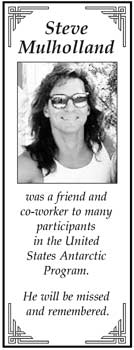Tragedy at South Pole:Skydivers' Fatal Jumpby Alexander Colhoun Three skydivers plunged to their deaths last Sunday [7 December 1997] while attempting what is believed to have been the first civilian skydiving attempt over the South Pole. The six-person team was organized by Adventure Network International (ANI), a company that has been assisting private adventurers in the Antarctic since 1988. All six members of the team jumped from a single Twin Otter aircraft from an elevation of approximately 18,000 feet. The South Pole rests at 9,500 feet above sea level, putting the parachutists nearly eight thousand feet above the snow-packed surface. The deceased were found within a mile of the station, two parachutes never having deployed and a reserve chute on a third person only partially opened. The South Pole doctor along with members of the trauma team were able to locate the bodies after a brief search. Three other skydivers, including two Norwegians and an American landed safely. Circumstances leading to the accident are still unclear. "The three guys were very experienced, with many hundreds of jumps each, skydived around the world and at the North Pole" said Michael McDowell of Adventure Network, in an Associated Press interview. Many South Pole workers were distraught by the accident, having watched the tragedy unfold from outside the tent structures they call home through the Austral summer. "I think more than anything there is a sense of disbelief at what happened," said one Antarctic Support Associates (ASA) employee. "Adventure network's Twin Otter landed at around seven and they were in the air preparing to jump by around nine. By ten the accident had happened, and by two they were gone. Just like a big black cloud drifted over the station." Adventure Network flew the bodies and survivors back to their base camp at Patriot Hills, located on the side of Antarctica closest to South America.
"Steve is one of those people that will be remembered here in our shop for many years because of who he was, he was definitely one of a kind," said Jay Burnside, Science Construction Coordinator for ASA. "If that isn't enough, Paula Adkins, out at Lake Hoare named the freezer after Steve a few years ago. The freezer is called the Mulholland and I suspect that name will carry on as a prelude to one of those great Antarctic stories." The story of this tragedy is sure to be carried for many years by staff at the South Pole this season, particularly as they work through the rest of this summer season. No nation has ownership of the South Pole or any location in Antarctica, thus private expeditions of this kind are entirely legal; however, the National Science Foundation and ASA offer no assistance to these groups. With no other organizations to turn to in times of crisis, the United States Antarctic Program has, over the years, become concerned about of private expeditions, the rescue of whom cuts into valuable resources, including flight time and risk to rescuers themselves. "From the point of view of the Antarctic program, [private expeditions] have the potential to hugely impact what we do," said Steve Dunbar, a search and rescue expert. Dunbar sighted the potential drain on resources (already being used at maximum capacity) that rescues often involve. Dunbar speculates that adventuring in Antarctica will only continue to grow in the years to come, an idea he perceives as a double edged sword. "The more people who get to see it, the more this place will be protected," said Dunbar. "But the more they come, the higher the chance of us getting involved." [The above article originally appeared in the 13 December 1997 issue of the Antarctic Sun; here is the original PDF version of the entire issue.] |
